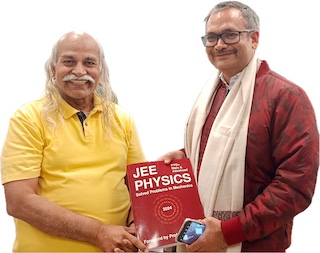Gravitational Potential and Field
Gravitational potential at a point P is the amount of work required to move a unit mass from infinity to the point P in a gravitational field. The gravitational potential of a particle of mass $M$ at a distance $r$ from it is given by \begin{align} V=-\frac{GM}{r}. \end{align} The unit of gravitational potential is J/kg. It is a scalar function.
The gravitational potential energy of a mass $m$ placed at a point P having potential $V$ is given by \begin{align} U=mV=-\frac{GMm}{r} \end{align}
A gravitational field of a point mass $M$ at a distance $r$ from it is given by \begin{align} E=-\frac{GM}{r^2}\hat{r} \end{align}
Problems from IIT JEE
Problem (JEE Mains 2014): The gravitational field in a region is given by $\vec{g}=5\,\hat\imath+ 12\,\hat\jmath$ N/kg. The change in the gravitational potential energy of a particle of mass 2 kg when it is taken from the origin to a point (7, -3) metre is
- 71 J
- $13\sqrt{58}$ J
- -71 J
- 1 J
Solution: Suppose a particle moves from a point A to another point B along some path in a gravitational field $\vec{g}$. The gravitational potential at B is given by, \begin{align} V_B&=V_{A}-\int_\text{path} \vec{g}\cdot\mathrm{d}\vec{l},\nonumber \end{align} where integration is carried out over the path taken by the particle. If $\vec{g}$ is constant then above equation can be written as, \begin{align} V_{B}=V_{A}-\vec{g}\cdot(\vec{r}_B-\vec{r}_A),\nonumber \end{align} where $\vec{r}_{A}$ and $\vec{r}_B$ are the position vectors of A and B.
The decrease in gravitational potential energy of a particle of mass $m=\unit{2}{\kilogram}$ when it moves from A(0,0) to B(7,-3) in gravitational field $\vec{g}=5\,\hat\imath+12\,\hat\jmath$ is, \begin{align} \Delta U & =m(V_A-V_B) \\ &=m\vec{g}\cdot(\vec{r}_B-\vec{r}_A)\nonumber\\ &=2(5\,\hat\imath+12\,\hat\jmath)\cdot(7\,\hat\imath-3\,\hat\jmath)\nonumber\\ &=2\;\mathrm{J}.\nonumber \end{align}
Problem (IIT JEE 1994): The magnitudes of the gravitational field at distance $r_1$ and $r_2$ from the centre of a uniform sphere of radius $R$ and mass $M$ are $F_1$ and $F_2$ respectively, then,
- $\frac{F_1}{F_2}=\frac{r_1}{r_2}$ if $r_1 < R$ and $r_2 < R$
- $\frac{F_1}{F_2}=\frac{r_{2}^2}{r_{1}^2}$ if $r_1 > R$ and $r_2 > R$
- $\frac{F_1}{F_2}=\frac{r_{1}^3}{r_{2}^3}$ if $r_1 < R$ and $r_2 < R$
- $\frac{F_1}{F_2}=\frac{r_{1}^2}{r_{2}^2}$ if $r_1
Solution: The gravitational field due to a uniform solid sphere of radius $R$ and mass $M$ at a distance $r$ from its centre is given by \begin{align} F=\begin{cases} \frac{GM}{R^3}r, & \text{if $r\leq R$;}\\ \frac{GM}{r^2}, & \text{if $r>R$.} \end{cases}\nonumber \end{align}
Problem (JEE Mains 2020): Consider two solid spheres of radii $r_1 =1$ m, $r_2 = 2$ m and masses $m_1$ and $m_2$, respectively. The gravitational field due to sphere 1 and 2 are shown. The value of $m_1/m_2$ is
- 2/3
- 1/6
- 1/2
- 1/3
Solution: The gravitational field on the surface of sphere 1 of radius $r_1=1$ m is, \begin{align} g_1&=\frac{Gm_1}{r_1^2} \\ &=\frac{Gm_1}{(1)^2}\\ &=Gm_1\\ &=2.\nonumber \end{align} The gravitational field on the surface of sphere 2 of radius $r_2=2$ m is, \begin{align} g_2 &=\frac{Gm_2}{r_2^2} \\ &=\frac{Gm_2}{(2)^2} \\ &=\frac{Gm_2}{4}\\ &=3.\nonumber \end{align} Divide above equations to get $m_1/m_2=1/6$.
Problem (IIT JEE 1997): A particle is projected vertically upwards from the surface of earth (radius $R$) with a kinetic energy equal to half of the minimum value needed for it to escape. The height to which it rises above the surface of earth is _______.
Solution: The expressions for escape velocity and minimum kinetic energy for a particle to escape from a planet of radius $R$ and mass $M$ are, \begin{align} v_e & =\sqrt{2GM/R},\\ K_\text{min} &=\tfrac{1}{2}mv_e^2 \\ &={GMm}/{R}.\nonumber \end{align} Initial potential energy and kinetic energy of the projectile are, \begin{align} U_i &=-\frac{GMm}{R}, \\ K_i &=\frac{1}{2}K_\text{min} \\ &=\frac{GMm}{2R}.\nonumber \end{align} At the maximum height $h$, the velocity of the projectile is zero. The potential energy and kinetic energy of the projectile at maximum height are, \begin{align} U_f &=-\frac{GMm}{R+h}, \\ &K_f=0. \end{align} Use conservation of energy, $U_i+K_i=U_f+K_f$, to get $h=R$.
